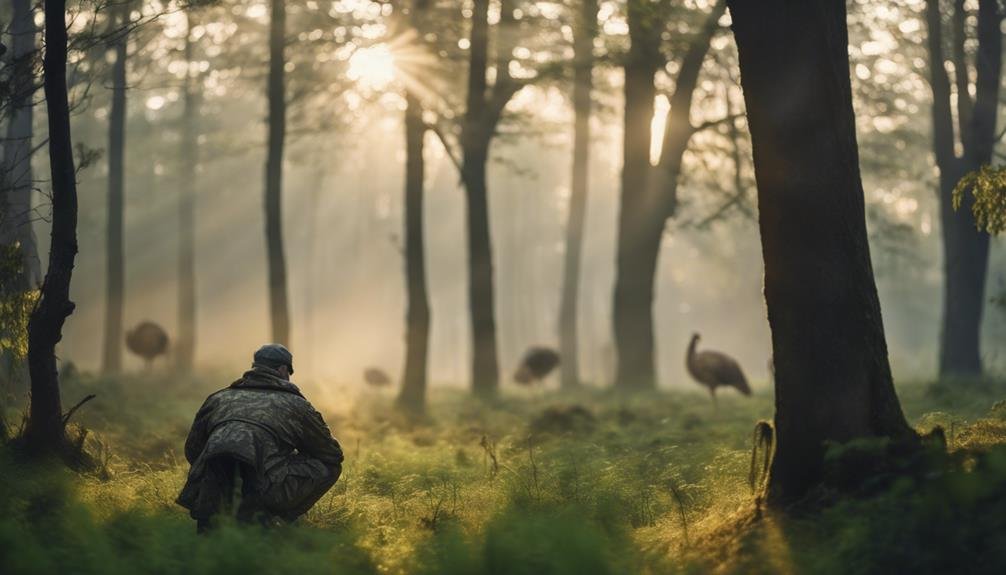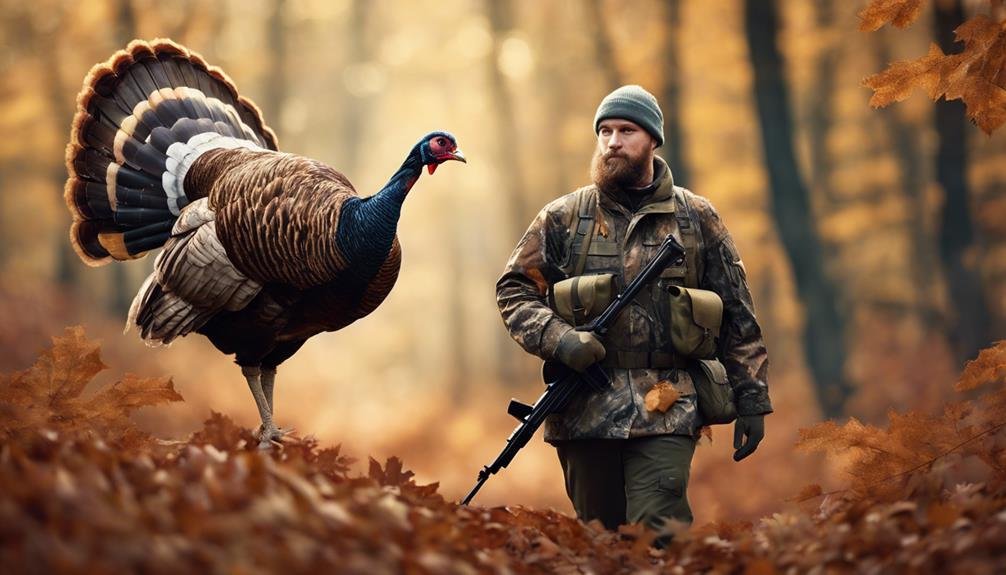Mastering the art of turkey hunting requires a deep understanding of hen behavior and psychology. A hen's social dynamics, language, and habits are intertwined, influencing her behavior and attracting gobblers. Female dominance shapes flock dynamics, and recognizing hen behavior is essential for successful hunting. By understanding hen preferences, habits, and vocal cues, hunters can create an authentic atmosphere, increasing their chances of tagging a bird. To take their hunting strategy to the next level, hunters must think like a hen, adapting their tactics to her needs and movements, and setting up ambushes in areas where she congregates.
Key Takeaways
- Understanding hen behavior and psychology is crucial for successful turkey hunting, as hens play a pivotal role in attracting gobblers.
- Recognizing hen vocalizations, schedules, and menus helps hunters create an authentic atmosphere, increasing the chances of tagging a bird.
- Hens congregate in areas with abundant resources, such as food and shelter, making these locations ideal for ambushes.
- Adopting a hen-centric mindset informs ambush locations and tactics, increasing the effectiveness of hunting strategies.
- Creating a realistic and subtle calling strategy, mimicking hen cues, can entice a gobbler to investigate, leading to a successful hunt.
Understanding Hen Behavior
As the entire spring season revolves around the hen, understanding her behavior is essential for turkey hunting success, and it all begins with recognizing that a hen's language, schedule, and menu are intertwined with her social dynamics. Hen socialization and flock dynamics play a pivotal role in shaping her behavior. Within a flock, hens establish a clear pecking order, with dominant hens leading subordinate ones. This hierarchy influences their behavior, particularly during mating season. A hen's language, schedule, and menu are all influenced by her social standing within the flock. By understanding these dynamics, hunters can better anticipate and respond to hen behavior, increasing their chances of tagging a gobbler.
Vocalization Mastery
Mastering hen vocalizations requires an understanding of the nuances of turkey language, as a hunter's ability to convincingly mimic a hen's clucks, purrs, and cackles can make all the difference in luring a gobbler into range. Effective vocalization mastery involves more than just mimicking sounds; it's about understanding the context and meaning behind each call. Here are some essential vocalization tips:
- Start with soft, subtle calls to imitate a hen's natural vocalizations
- Vary your calling strategies to adapt to different hunting scenarios
- Use vocalizations to create a sense of realism and authenticity
- Practice your calling techniques to develop a natural, effortless sound
- Keep your calling concise and infrequent to avoid overcalling
Mimicking Hen Cues
Mimicking hen cues involves recognizing and replicating the subtle vocal and visual signals that hens use to communicate with toms, thereby increasing the likelihood of drawing a gobbler into range. Understanding hen psychology and turkey sociality is vital in this process. Hens use a range of vocalizations, including clucks, purrs, and cackles, to convey specific messages to toms. By mimicking these cues, hunters can create the illusion of a hen's presence, enticing a gobbler to investigate. However, moderation is key; real hens rarely communicate loudly and frequently. By mastering the art of mimicking hen cues, hunters can increase their chances of success in the field.
Reading the Hen's Room
In the world of turkey hunting, a hunter's ability to read the hen's room – understanding her behavior, body language, and vocal cues – is essential to successfully luring a gobbler into range. This requires a deep understanding of hen psychology and how to create hunting harmony.
Recognize the hen's schedule** and menu to anticipate her movements and behavior.
**Identify her vocalizations, such as clucks, purrs, and cackles, to mimic her language effectively.
- Pinpoint the resources she needs, including food, shelter, and companionship.
- Scout her favorite habitats, including hardwoods, green slopes, and new growth areas.
- Set up ambushes near her preferred areas, like open fields and shelterbelts, to increase the chances of tagging a gobbler.
Hen-Centric Hunting Strategies
By structuring their hunt around the hen's preferences, behaviors, and habitats, hunters can substantially increase their chances of bagging a gobbler. A deep understanding of hen psychology is essential, as it allows hunters to anticipate and adapt to the hen's needs and movements. In the spring, hens prioritize food sources, shelter, and companionship, making areas with abundant resources, such as lush creek beds and adjacent hillside habitats, prime hunting spots. By mimicking the hen's vocalizations and behaviors, hunters can create an authentic and appealing environment that attracts gobblers. By focusing on the hen's needs and preferences, hunters can increase their chances of success in the field.
Deciphering Hen Language
A hen's vocal repertoire, consisting of clucks, purrs, yips, and cackles, serves as a complex language that, when deciphered, can reveal her emotional state, intentions, and surroundings. Understanding hen language is essential for successful turkey hunting. Different hen dialects and vocalization patterns can convey information about a hen's mood, location, and intentions.
- Recognizing the distinct sounds and patterns of hen language can help hunters pinpoint a hen's location and emotional state.
- Hens use specific vocalizations to communicate with poults, signal alarm, or express contentment.
- Regional dialects and accents can vary among hens, making it essential to familiarize oneself with local hen language patterns.
- Paying attention to hen vocalizations can help hunters anticipate gobbler behavior and adjust their strategy accordingly.
- By deciphering hen language, hunters can gain a deeper understanding of turkey behavior and increase their chances of success.
Resource Reconnaissance
Scouting before and after each season is a worthwhile investment, as understanding the dynamics of resource availability and hen behavior can make all the difference in tagging a gobbler. Hens have specific habitat preferences, and identifying these areas can increase the chances of encountering a gobbler. Food sources, such as mast crops, green slopes, and new growth, are essential for hens, and toms will often follow them to these areas. By understanding what resources are available and how they change throughout the season, hunters can pinpoint areas where hens are likely to congregate, increasing the likelihood of encountering a gobbler. This knowledge can be used to set up effective ambushes and increase the odds of tagging a bird.
Scouting for Hen Hotspots
During the spring season, identifying areas where hens congregate is essential, as these hotspots often attract toms, and understanding what makes these areas attractive to hens can greatly increase the chances of tagging a gobbler.
When scouting for hen hotspots, consider the following key factors:
- Creek corridors with dense vegetation and abundant food sources, such as berry bushes or grasslands, are often favored by hens.
- Spring habitats with newly sprouted vegetation, like alfalfa or clover fields, can be particularly attractive to hens.
- Look for areas with a mix of open fields and timber stands, providing shelter and roosting sites.
- Hens often prefer areas with a reliable water source, such as a creek or pond.
- Edge habitats, where different vegetation types meet, can also be productive areas for hen activity.
Identifying Hen Preferences
By pinpointing the specific features that attract hens to particular areas, hunters can refine their search for hotspots and increase their chances of encountering a gobbler. Identifying hen preferences is essential in this process. Hens are drawn to areas that offer suitable hen habitat, characterized by dense vegetation, water sources, and adequate nesting sites. Their feed preferences also play a significant role, as they tend to frequent areas with an abundance of food sources such as insects, seeds, and grains. By understanding these preferences, hunters can focus their search on areas that are likely to attract hens, increasing their chances of tagging a gobbler.
Setting Up Hen Ambushes
To optimize ambush locations, hunters should focus on areas where hens are likely to congregate, such as open fields, woodland edges, and creek bottoms, as these areas often provide the resources and shelter that hens require.
- Creek Corridors: Lush creek bottoms with adjacent hillside havens offer a mix of open fields and timber stands, providing hens with quality nesting habitat and shelter from toms.
- Hillside Havens: Hillside areas with a mix of open fields and timber stands provide hens with shelter, food, and companionship.
- Woodland Edges: Border zones between open fields and woodlands offer hens shelter, food, and protection from predators.
- Open Fields: Open fields with nearby shelterbelts provide hens with food, shelter, and a place to socialize.
- Shelterbelts: Thick shelterbelts surrounding open areas offer hens protection from toms and predators, making them ideal ambush locations.
Effective Hen-Thinking Tactics
In the pursuit of a successful turkey hunt, adopting a hen-centric mindset is essential, as it allows hunters to think like their quarry and anticipate the behaviors and habitats that will attract a gobbler. Effective hen-thinking tactics involve understanding hen psychology and acknowledging female dominance in turkey social dynamics. By mimicking natural hen vocalizations, hunters can create an authentic atmosphere that draws in a gobbler. Additionally, recognizing the importance of resources, such as food and shelter, and setting up ambushes in areas where hens congregate can increase the chances of tagging a bird. By putting themselves in the shoes of a hen, hunters can develop a deeper understanding of turkey behavior and make more informed decisions in the field.
Frequently Asked Questions
How Do I Transition From Calling to Shooting Without Spooking the Turkey?
When shifting from calling to shooting, remain calm, freezing in place, and slowly bring your gun to a ready position, avoiding sudden movements that might spook the turkey, ensuring a clean shot.
What's the Ideal Time of Day for Hunting Turkeys During the Spring Season?
As morning's golden light creeps over the horizon, like a silent predator stalking its prey, the ideal time for hunting turkeys during the spring season is during Morning Movement, specifically the Dawn Patrol, when birds are most active and vocal.
Can I Use Hen Calls During the Fall Turkey Hunting Season?
During the fall season, hen calls can be effective, but with caution; use subtle, soft calls to mimic brood hens, and consider pairing with hen decoys to create a realistic fall strategy, capitalizing on juvenile curiosity and flock dynamics.
How Do I Handle a Situation Where Multiple Toms Respond to My Calls?
When multiple toms respond to your calls, employ multiple strategies, adapting to tom dynamics. Use subtle, realistic vocalizations, then pause, allowing dominant birds to assert dominance, and be prepared to adjust your calling to match the unfolding scenario.
What's the Best Way to Deal With a Silent or Non-Responsive Gobbler?
When dealing with a silent or non-responsive gobbler, employ patience tactics, recognizing that gobblers can be moody or distracted. Avoid over-calling, instead, wait for the bird to reveal its location, as understanding gobbler psychology is key to successful turkey hunting.
Conclusion
As the curtain falls on the turkey hunting season, the astute hunter's mind remains attuned to the rhythmic cadence of hen behavior. By internalizing the language, habits, and habitats of these avian queens, hunters can orchestrate a symphony of success, harmoniously blending strategy and stealth. As the forest whispers its secrets, the hen-thinking hunter stands poised, ready to strike, their senses honed to the subtle nuances of the wild, prepared to outwit and outmaneuver the cunning gobbler.









